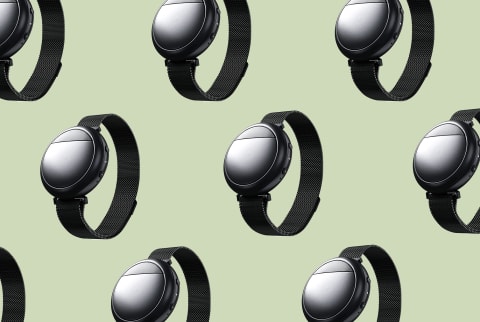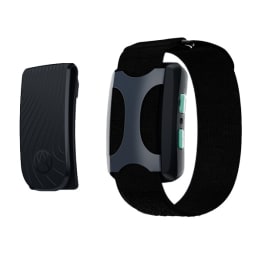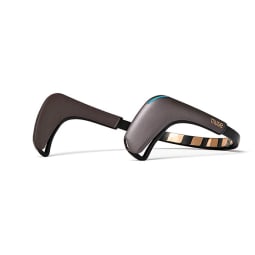While a great (and potentially life-changing) concept, opinions are mixed on whether these devices can actually help relieve stress. To learn more about the science behind stress and how these devices are meant to reduce it, we spoke with experts and researched the options available today. Below, find our picks for the best wearable stress relief devices of 2023—and hear what experts have to say about this technology. These vibrations are often made through low-frequency (20 to 200 hertz), or infrasonic sound waves (below 20 hertz), which are extremely quiet and often barely detectable by the human ear1. Some devices use binaural beats, or two almost equal tones at different frequencies, to stimulate a stress response. There has been limited research on this technique, but a 2017 study showed a binaural beat pattern to be an effective way to induce a meditative state2. Another 2019 study that looked at the efficacy of High Amplitude Low Frequency-Music Impulse Stimulation (HALF-MIS) as an add-on treatment for depression had very positive results, finding the treatment to be more effective than standard depression treatment alone3. Many stress relief devices tap into this technique, using music and/or vibration to stimulate the vagus nerve and prompt a natural calming response in the body through the parasympathetic nervous system. While brands and plenty of users say these wearables are a great stress-reducing alternative to medication and negative coping habits, the research isn’t all there yet. Much information is lacking around the study methods and participants themselves—and few, if any, of these studies are peer-reviewed. According to NYC neuropsychologist Sanam Hafeez, measuring stress isn’t as simple as some of these devices make it out to be. “The nature of stress is complex,” Hafeez says. “Although things like sweat and increased heart rate can be measured by technology, they don’t always indicate anxiety. A cookie-cutter approach to stress relief is unlikely to work for all. For a stress relief device to be effective, it needs to collect data precisely, process that information, and accurately identify stress.” Still, especially when paired with more budget-friendly approaches to stress management (such as journaling, movement, and meditation), wearable stress relief devices can be a helpful addition to your self-care arsenal. And if they help you find even a few moments of calm in the midst of a hectic day, it could be well worth the investment. Unlike other options, Apollo Neuro is designed to be worn all day long, providing you with silent yet soothing vibrations that are meant to retrain your nervous system so you can respond better to all of life’s stressors. The Apollo Neuro sends silent, calming vibrations to the body, which are unobtrusive to your day, but relaxing for your body and mind. With the corresponding app, you can view your tracked metrics and choose one of the pre-programmed modes based on your goals, or make your own customized schedule for the device. What’s more, this device can be worn in a multitude of ways (on your wrist, ankle, waistband, chest, or clipped to your shirt) by adults and children, and has the research to back its efficacy. The company’s co-founder, Dave Rabin, is a board-certified psychiatrist and neuroscientist who has studied stress for over 15 years. The brand has completed six clinical trials, with nine ongoing. According to the Apollo website, preliminary results suggest an impressive improvement in sleep, heart rate, and heart rate variability, after wearing the device for 3+ hours a day, 5+ days a week over the course of 3 months. On Apollo’s website, the device boasts 4.7 stars, with reviewers commenting on the discreet design and how it eases even some of the most intense forms of anxiety. One reviewer writes, “Ever since I got this product I have been able to drive again. Still have PTSD… But this helps control the episodes so I can function on the road.” The Sensate uses those previously mentioned infrasonic frequencies to stimulate your vagus nerve and signal your body to relax. These vibrations are paired with soundscapes that were specifically developed by the brand to help induce a state of calmness, safety, and relaxation. To check in on how well the Sensate is working, the brand recommends measuring your heart rate variability. While the device does not measure this for you, there are plenty of great HRV trackers out there. In 2022, the brand commissioned a study in adults who used the Sensate for an average of 3.5 months, 5 to 6 days per week. According to the brand’s website, over 70% of the participants scored in the low, mild, or normal stress classifications. Additionally, over 65% with anxiety disorder and over 50% with a depressive disorder noted an improvement in their condition when using the device. According to the brand, neuroscience researchers around the world use this EEG device. The headband-style wearable has seven sensors that can detect when you’re losing focus, which prompts soundscapes that gently guide you back to a calmer state. In the corresponding app, you’ll be given insights to help you stay calm and focused throughout the day. Your results are shown in a series of graphs and charts which show your brain, heart, and breathing activity. The app makes it easy to understand what’s going on in your mind, and how you might make adjustments to feel more relaxed and at ease. The wireless device has a USB-port for charging and is adjustable to fit your head comfortably. Just note, there are no earbuds attached to the headband. Instead, you can pair it with your own headphones through bluetooth to play the meditations. The brand also offers a sleep tracking wearable, the Muse S, which tracks your sleep patterns to help you achieve a deeper, more restorative sleep. You can get on-demand relief through the push of a button on the device, or program it through the app, where there’s an option to set a specific temperature and duration (as short as 5 minutes or up to 9 hours). The app can also be used to track your usage and view any patterns. A 2019 4-week randomized study looked at the effectiveness of this thermal treatment method in 39 women ages 45 to 58. Positive results suggested that this type of thermal intervention may provide sleep benefits, especially when it comes to falling asleep and staying asleep while experiencing hot flashes. With over 1,000 reviews on the brand’s website, the device has a 4.2 rating overall. Most people say it works well and one writes, “I am truly amazed at how fast I cool off from a hot flash. Love this Embr wave and I can’t imagine life without it again. Amazing product!” Others comment on the various modes and programs, describing the device as “worth every penny.” The only complaint seems to be around the battery life, which a few reviewers note could be better. Choose from three different speed settings: slow speeds for sleep or meditation, or faster speeds for managing anger and intense stress. Once prompted, the wearable will vibrate until you manually turn it off. There are no reviews on the brand’s website, but the device has a 4.4 overall rating on Google, Reviewers sing their praises for Touchpoints’ customer service and the gadget’s simple yet effective design. Multiple people say the device makes a “huge difference” in managing anxiety and that they use it close to daily.








